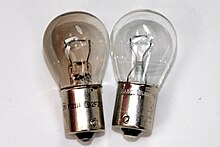Brake light
The brake lights are a part of the vehicle lighting that is found at the rear of the vehicle and is directed towards the rear. They usually light up when the vehicle driver presses the brake pedal to warn the driver of the vehicle behind about the braking process. According to § 53 StVZO, two brake lights must be installed in all motor vehicles and their trailers that are registered in Germany . According to EU law, new vehicles have had to have a third brake light since January 1, 1998 (76/756 / EEC in conjunction with ECE-R48).
history
In 1938, Section 53 (3) of the StVZO stipulated “one or two yellow-red brake lights” for motor vehicles in Germany. Exceptions existed for agricultural and forestry tractors up to 20 km / h as well as motorcycles and wheelchairs. The type approval requirement for vehicle parts, especially the lighting equipment, took place on January 1, 1954. For vehicles that were first registered before January 1, 1983, yellow brake lights were also permitted. Since January 1, 1988, brake lights have also been mandatory on motorcycles with a BBH of more than 50 km / h. The brake lights must shine with a red light to the rear. The luminosity must be so bright that it can also be seen during the day. On most vehicles, the two brake lights are integrated into the rear lights on the left and right. The light bulb can have its own socket or it can be combined with the tail light in a two-filament light bulb. The third brake light is in the center of the rear of the vehicle and higher than the two side lights. Nowadays it usually consists of an LED strip. In trucks , two brake lights are usually part of the tail lights. However, depending on the purpose and type of structure, additional brake lights can be attached.
function

The lights are operated via the brake light switch. The brake lights are activated either directly via an electromechanical button or a proximity switch on the brake pedal. There are also versions that are actuated by the pressure build-up in the hydraulic brake system. In modern vehicles, the signal is sent to a control unit . This activates the lights and forwards the information to other control devices (e.g. EDC ) via the CAN bus .
The adaptive brake light lights up or flashes over a large area in the event of heavy braking or emergency braking (e.g. with two brake lights on each side).
Special regulations

Yellow brake lights were only common until the beginning of the 1970s and are now only found occasionally on vintage cars and on trams. The brake light signal is switched to the direction indicator line in such a way that the direction indicator has priority, i.e. H. when braking without flashing, both (all) brake / flashing lights light up. If it flashes at the same time, the light on the "flashing side" flashes, the other one continues to glow. This circuit makes it possible to use only two single-filament incandescent lamps to implement all the light signals of a motor vehicle that are to be emitted to the rear. Small, often round rear lights with only two chambers are usually used for this purpose. A single-chamber light with a single two-filament light bulb and a red cover lens was also common in classic cars (e.g. VW Beetles) and many US vehicles. The priority circuit (flashing light before brake light) is also used here. Nowadays, especially for larger truck taillights with at least five chambers, several functions are then equipped twice or more than once.
Two additional brake lights behind the rear window were particularly popular in the 1980s.
literature
- Robert Bosch (Ed.): Autoelectronics Autoelectronics. 5th, completely revised and expanded edition. Vieweg & Sohn Verlag, Wiesbaden 2007, ISBN 978-3-528-23872-8 .
- Jürgen Kasedorf, Richard Koch: Service primer for vehicle electrics. 15th edition. Vogel Buchverlag, 2007, ISBN 978-3-8343-3098-7 .
- Rudolf Hüppen, Dieter Korp: Car electrics all types. Motorbuchverlag, Stuttgart, 1968, ISBN 3-87943-059-4 .
- Hans-Hermann Braess, Ulrich Seiffert: Vieweg manual automotive technology. 6th edition. Vieweg + Teubner publisher, Wiesbaden 2011, ISBN 978-3-8348-1011-3 .
Web links
Individual evidence
- ^ Road traffic law. Beck Verlag, Munich / Berlin 1941, p. 116.
- ↑ TÜV Rheinland Handbook Oldtimer: Registration - Purchase - Trends - Value Retention. Kirschbaum Verlag, Bonn 2016, ISBN 978-3-7812-1943-4 , p. 94.
- ↑ § 72 StVZO: Transitional provision to § 53 Paragraph 2 (color of the brake light).
- ↑ adac.de ( Memento of the original from September 29, 2016 in the Internet Archive ) Info: The archive link was inserted automatically and not yet checked. Please check the original and archive link according to the instructions and then remove this notice. Transitional provisions for motorcycles (accessed September 20, 2016)
- ↑ § 53 (2) No. 1 StVZO.
